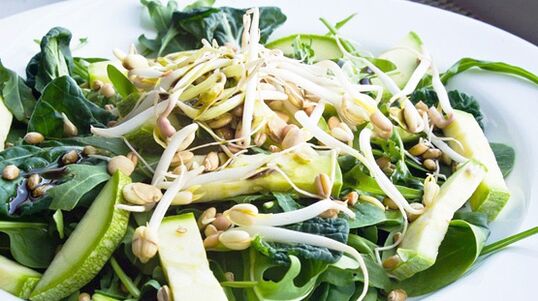
Let's say right away. Most of the "Japanese" diets on the net have nothing to do with Asian cuisine or the diet discussed below.. Typically, theseJapanese dietsit is recommended to eat a "bird's" portion of cooked cabbage, a few eggs and 100 grams of meat or fish a day, reduce the number of meals to three and live in this mode for up to 2 weeks. No! Such a small diet is not suitable for an active worker.
Why is the Japanese theme and everything that mows underneath so popular?
The country of the rising sun will always be attractive and incomprehensible to a European. This is perhaps due to the fact that Japan has long been a closed state for Western civilization. Who are they, the Japanese, in our traditional view? They are technological but believe in spirits; conservative but invented the "Ganguro" style; restrained but able to detach wildly; appreciate life even in a tiny stem, but historically elevated suicide to the rank of a venerable ritual. The islanders gave the world the most beautiful engravings and Pokémon. they are thin and live long, why?
You can talk about genetics and physiology, or you can answer like this: we are what we eat.
The article is based on Elisa Tanaka's book The Japanese Diet.
Traditional ingredients of Japanese cuisine
I lay down in the shadows
My rice is pushing me
Mountain Creek.
Rice
For the Japanese, rice, like bread for us, is "the head of everything. "It is a healthy source of carbohydrates that it does not containGlutenfree. Residents of Japan consume a variety of rice varieties, but prefer to eat brown rice cooked with sesame oil.
Fish and seafood

In terms of the amount of fish dishes, they are in second place in the daily diet of the inhabitants of the country of the Rising Sun. The protein structure of fish meat is complete, easy to digest, and contains essential amino acids for humans. However, the Japanese do not eat smoked or salted fish - only fresh sea or fresh water. The fat in the fish is meltable and does not deposit vile cellulite on the thighs, but gives the body full polyunsaturated fatty acids.
Seaweed
Seaweed (also known as seaweed, brown seaweed) is widely used in Japanese cuisine: it is added to rice, fish dishes or soy dishes. Laminaria is a good prevention of thyroid diseases, atherosclerosis and myocardial infarction, rich in iodine, minerals and macronutrients. In addition, residents of the Japanese islands use dry seaweed instead of the usual table salt.
Vegetables and legumes
True Japanese cuisine is impossible without vegetables. It is, of course, all kinds of cabbage, radishes, garlic, green onions, cucumbers and tomatoes, eggplant, carrots, peppers, legumes, asparagus, spinach, celery and all kinds of salads.
Germs and shoots

They are valuable sources of nutrients, as the germs are consumed in "live" form - meaning heat treatment does not kill the benefits. In addition, germinated grain is more useful than "sleeping" grain because all life processes are activated in it.
advice: germ can be obtained at any large hypermarket, or you can germinate the eyes yourself through the window. Take 2 tablespoons of seeds or grains, place in a bowl and fill with water at room temperature so that the level of the liquid is 6 cm above the surface of the grains. Let stand for 7-12 hours, covering the container with gauze. Then drain the water and rinse the beans thoroughly. The germs should be kept in the dark, they can be eaten for salads, soups, or to replace the greens in the second dish. Just don’t make large stocks for later use.
Fruits and berries
Instead of traditional pastries and sweets, Asians eat fruit as a dessert. However, it is important to eat fruit and berries during the season, i. e. not strawberries in winter.
Spices and condiments
Curry, black, red and cayenne peppers, anise, turmeric, garlic, horseradish, dill, ginger (fresh and pickled), basil, mustard seeds, coriander and cinnamon are usually included in many dishes. But the bay leaf, on the contrary, is not used. Salt is not highly valued either, instead dry seaweed powder (as already mentioned), soy sauce or sesame oil is used.
Green tea

Tea is believed to have many medicinal properties: it strengthens teeth, soothes the soul, cures heart disease, neutralizes toxins and promotes longevity. The principle of Japanese tea drinking is "Drinking — dividing, refilling — drinking. " The second cup of tea is considered the most valuable (especially if you brew the tea in the cup itself).
advice: to make the tea fragrant and as useful as possible, first rinse the teapot with boiling water and close the lid to warm it up. Then rinse the tea leaves in warm water and put 1-2 tsp in a teapot. for a cup of tea, fill the tea leaves with water not warmer than 80 ° C. First, pour water into one-third of the teapot and let stand for 3-5 minutes. Then fill in half and leave again, but for 1 minute. Then add as much water as you need for the tea and let it cook for a minute. The tea is ready.
Tofu (bean curd)
Bean goulash provides Asian vegetarians with complete protein: 240 g of tofu contains as much protein as two chicken eggs. 100 g of tofu is 20% richer in calcium than 100 g of cow's milk. Soy protein is 95% digestible, rich in lysine, calcium, iron, vitamins B, E and K. Tofu is an excellent dietary product and despite its high nutritional value, bean goulash is low in calories. There is little in itcarbohydratesand no cholesterol. Unlike meat, which is acidic, tofu is alkaline. And nutrition experts say an alkaline environment is more beneficial than an acidic one and advise eating at least 25 grams of soy protein a day.
Benefits of the Japanese diet
Many people do not tolerate diet simply because diet severely limits their taste, sometimes too much to limit what we eat. Enjoying the taste of food is a pleasure that cannot be left out for long without spoiling your well-being and mood. The real Japanese diet consists of delicious foods made from healthy and low-calorie products for the body.
Disadvantages of the Japanese diet
The diet assumes that you need to master some recipes for Asian food and also requires some adaptations. This diet is technically more complicated than many others, where you only eat and eat a few foods for a while or until you get sick of them.
Studying Japanese cooking techniques can be seen as another skill in the arsenal than the ability to sit on a string - it can be surprising, you can be proud of that.
So you will need from the kitchen set:
- Wok, or wok for quick frying or steaming;
- Non-stick coated pans;
- Double boiler (instead of a double boiler you can put a metal filter in the pan);
- Food processor, mixer;
- Wooden pots made of beech, cherry or maple for mixing cooked food: the wood does not absorb odors and lasts a long time;
- Wooden skewers or skewers.
You will need it for cooking:
- Various types of rice;
- Pasta;
- Mushroom;
- Spices and herbs;
- Sauces: soy, teriyaki, fish, oysters.
Japanese food shouldn’t be a big problem for you, now you can buy it in any hypermarket or easily replace it with some of our ingredients. Don't be afraid to experiment.
Japanese diet: principles

The Japanese diet menu includes a variety of soups and vegetable dishes.. This is a great weight loss strategy because foods like these are low in calories and good for digestion. And the plant-based fiber in the composition of vegetables gives your stomach the necessary saturation so you won’t feel unbearable hunger attacks.
The amount of calories in the menuwithout the addition of sugar or cream to beverages. Therefore, do not forget to add 1 teaspoon of 16 kcal to your daily caloric intake. sugar and 36 kcal per tablespoon of cream (if used). In other words, sweetened coffee reduces the amount of the main portion of food. It is recommended to use soy instead of cow's milk.
The optimal number of calories consumed per day should be in the range of 1200-1400 kcal (for women). This number of calories is enough for the body to live at rest, before meals and at average ambient temperatures. On the one hand, reducing your calories to 1200-1400 doesn’t cause abnormal metabolic changes, on the other hand, it allows you to live your day to the fullest (don’t feel like crashing), and fitness classes get energy by burning your body. own fat reserves.
Dangers of diets that reduce calories below 1200:
- With quick weight loss, you quickly pick up the pounds you lose or even more;
- An exhausted diet negatively affects the condition of the skin, hair and nails and leads to loss of muscle mass;
- The more muscle you lose, the more your metabolism slows down, making it harder to lose weight or maintain weight.
The main rules of the Japanese diet
- Do not try to artificially accelerate the weight loss process, reducing the number of calories (the consequences have been described above). You should lose no more than 1 kg per week.
- Stay in the range of 1200-1400 calories per day. Be sure to supplement with vitamins and minerals.
- Maintain energy balancebetween the energy received and consumed. We get calories from food, we spend it with the help of fitness. Violation of this balance unfortunately leads to overweight.
- The key to weight loss in the Japanese diet is a variety of foodsand in small portions, the transition from fatty meat dishes to a healthy diet based on fruits, vegetables and seafood.
Asian nutrition researchers have developed a healthy nutrition pyramid that can serve as a guide when planning the proportions of a diet and the foods it contains.
Tips for effective weight loss in the Japanese diet
- Keep track of your physical activity and diet (calorie count). This makes it easier to detect progress;
- Strictly adhere to your chosen meal plan and portion sizes;
- Don’t think food is "good" or "bad, " enjoy the process of eating;
- If you could afford high-calorie foods on any given day, be sure to reduce the caloric content of your diet the next day;
- Do aerobic exercises.
Initially, you may lose more than the recommended one kilogram per week. This is due to the loss of fluid in the body. This is when weight loss slows down, but don’t despair - it’s a completely normal healthy weight loss process.
Sample Japanese diet menu for 14 days (table)
| Day | Menu for the day | |||
| Breakfast | Lunch | Snack | Lunch dinner) | |
| one |
|
|
Apple. Calories: 80. |
|
| Total daily caloric intake1428 kcal | ||||
| 2 |
|
|
1 cup of coffee without sugar. Calories: 5. |
|
| Total daily caloric intake1386 kcal | ||||
| 3 |
|
|
1 glass of soy milk. Calories: 150. |
|
| Total daily caloric intake1334 kcal | ||||
| four |
|
|
Calories: 30. |
|
| Total daily caloric intake1424 kcal | ||||
| 5 |
|
|
1 orange (fruit salad) Calories: 141. |
|
| Total daily caloric intake1443 kcal | ||||
| 6 |
|
|
|
|
| Total daily caloric intake1433 kcal | ||||
| 7 |
|
|
1 glass of soy milk. Calories: 150. |
|
| Total daily caloric intake1392 kcal | ||||
| eight |
|
|
1 glass of vegetable juice. Calories: about 70. |
Calories: 576. |
| Total daily caloric intake1424 kcal | ||||
| 9 |
|
|
120 g of fruit yogurt. Calories: 60. |
|
| Total daily caloric intake1440 kcal | ||||
| ten |
|
|
10 young carrots. Calories: 38. |
|
| Total daily caloric intake1303 kcal | ||||
| eleven |
|
|
|
|
| Total daily caloric intake1290 kcal | ||||
| 12 |
|
|
|
|
| Total daily caloric intake1441 kcal | ||||
| 13 |
|
|
1 bowl of cherries. Calories: 31. |
|
| Total daily caloric intake1430 kcal | ||||
| fourteen |
|
|
10 young carrots. Calories: 38. |
|
| Total daily caloric intake1272 kcal |
If you’re a little scared of the names of the foods (which you’ve probably never cooked) - then don’t worry, there are recipes for all the foods on the Japanese diet.
The results are saved
You should leave the diet, gradually increasing the number of calories to a level where you can keep your weight unchanged. Just add 100 calories to your diet for 14 days. However, the weight should be checked. If the balance continues to lose weight, add an additional 100 calories over the next 2 weeks and check the balance again. Once your weight has stabilized, you determine the number of calories you need to maintain a constant weight.
100 calories:
- pork, beef - 80 g;
- 1 cooked chicken breast;
- 150 g hal;
- one egg or 2 yolks or 5-6 proteins;
- a glass of milk;
- yogurt - 125 g;
- a glass of kefir;
- a small slice of bread;
- beans - 25 g (3-4 tablespoons);
- fresh cabbage - 1 kg;
- fresh cucumbers - 750 g;
- 3-4 large carrots;
- a large potato tuber;
- 590 g tomatoes;
- 625 g of sauerkraut;
- bananas - less than 1 piece;
- apricots - 210 g;
- fresh strawberries - 325 g;
- 1 large apple;
- 1 large orange;
- 2 kiwi;
- peaches - 250 g;
- 4 mandarins;
- plums - 200 g;
- 1 grapefruit;
- watermelon - 285 g;
- 1 large pear;
- melon - 190 g;
- 15-20 large grapes;
- any walnut (2 tablespoons) - 15 g;
- pasta - a handful of portions;
- muesli, oatmeal - 1/3 cup;
- porridge on the water - 5-6 tablespoons. l. per serving.
We hope you succeed! Good luck!

















































































